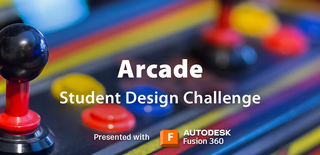Introduction: DIY Arcade Game Bluetooth Controller for Desktop Devices
Arcade games have long captivated players with their nostalgic appeal and immersive gameplay experience. From classic titles like Pac-Man to modern favorites, the arcade cabinet design and controls offer a unique thrill that many enthusiasts seek to replicate at home. In this project, we will guide you through the process of building your own arcade game Bluetooth controller for Desktop devices. By integrating components like the ESP32 microcontroller, toggle switch buttons, a joystick mechanism, and a custom-built cabinet, you can recreate the authentic arcade feel and enjoy your favorite games on your mobile or tablet device.
Supplies
- ESP32 microcontroller (e.g., ESP-WROOM32)
- Connection wires
- 10k ohm resistors
- Toggle switch buttons
- Joystick mechanism
- Medium-density fiberboard (MDF) for cabinet construction
- Glue for assembly
- Power supply battery
- Device holder
- Ping pong ball
- Metallic pen body
- Metallic thumb pins
Step 1: Understanding Arcade Gaming
Before diving into the construction process, it's essential to grasp the essence of arcade gaming. Arcade games offer an exhilarating experience characterized by fast-paced gameplay, responsive controls, and immersive graphics. Recreating this experience at home allows you to relive the nostalgia and excitement of classic arcade gaming.
Step 2: Designing the Controller Cabinet
Begin by planning the layout and dimensions of your arcade controller cabinet. MDF board serves as an ideal material for its durability and ease of customization. Design the cabinet to accommodate the joystick, toggle switches, and device holder, ensuring ergonomic placement for comfortable gameplay.
aRCADE CABINATE
Step 3: Assembling the Components
Mount the joystick mechanism and toggle switch buttons onto the MDF board according to your layout design. Use glue to secure the components firmly in place, ensuring they align correctly for optimal functionality.
Step 4: Incorporating Metallic Thumb Pins Mechanism
Utilize metallic thumb pins to create a 4-directional switch for movement control in PPSSPP. Attach metallic thumb pins in a square formation on the MDF board, with each pin representing up, down, left, and right directions. Place a ping pong ball over the pins and encase it within a metallic pen body. When pressed, the ping pong ball makes contact with the pins, registering directional inputs.
Step 5: Wiring the Circuit
Connect the ESP32 microcontroller to the toggle switch buttons and joystick using appropriate connection wires. Integrate 10k ohm resistors into the circuit to prevent signal interference and ensure smooth operation. Follow the wiring diagram specific to your components to establish reliable connectivity.
i,e., connect GPIO pins with a push button and 10k ohm resistor with GND pin.
Step 6: Installing the Power Supply
Incorporate a power supply battery into the controller setup to provide uninterrupted power during gameplay. Ensure the battery is compatible with the ESP32 microcontroller and capable of delivering sufficient voltage for optimal performance.
Step 7: Adding the Device Holder
Attach a secure device holder to the arcade controller cabinet, allowing you to mount your Desktop device or tablet for gaming purposes. Choose a holder with adjustable features to accommodate various device sizes and ensure a stable, hands-free gaming experience.
Step 8: Uploading the Code
Write the necessary code for the ESP32 microcontroller to communicate with your Desktop device. Compile the code and upload it to the microcontroller using a USB cable and appropriate programming software.
Attachments
Step 9: Final Assembly
Once satisfied with the performance and code upload, proceed to finalize the assembly of the arcade game Bluetooth controller. Secure all components firmly in place within the cabinet structure, ensuring stability and durability for long-term use.
To map buttons effectively in the PPSSPP application for desired functionality, open the PPSSPP emulator on your desktop and access the "Settings" menu. Navigate to "Controls" settings, where you'll find options for button mapping. Click on each function such as "Up," "Down," "Left," "Right," "Action," and "Start," and assign them to the corresponding buttons on your DIY arcade controller. Ensure thorough testing of each button's functionality to ensure proper mapping.
Some popular games available for PPSSPP Arcade include:
- Dragon Ball Z: Shin Budokai
- Tekken 6
- Grand Theft Auto: Vice City Stories
- God of War: Chains of Olympus
- Persona 3 Portable
- Lumines II
- Soulcalibur: Broken Destiny
- Final Fantasy Tactics: The War of the Lions
- Metal Slug Anthology
- Street Fighter Alpha 3 Max
These titles span across various genres, offering diverse gaming experiences tailored for arcade enthusiasts on the PPSSPP emulator platform.
Step 10: Enjoying Arcade Gaming on Desktop
With your DIY arcade game Bluetooth controller complete, connect it to your Desktop device and launch your favorite games through the PPSSPP emulator. Immerse yourself in the nostalgic thrill of arcade gaming, relishing the authentic experience from the comfort of your own home.
Step 11: Congratulations !!
Building a DIY arcade game Bluetooth controller for Desktop devices offers a rewarding opportunity to recreate the excitement of classic arcade gaming. By integrating various components and incorporating a metallic thumb pin mechanism for directional control, you can craft a custom controller with responsive controls and ergonomic design. Embark on this project to indulge in the timeless appeal of arcade gaming and enjoy countless hours of entertainment on your Desktop device.

Participated in the
Arcade Student Design Challenge












